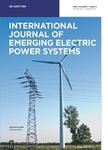版权所有:内蒙古大学图书馆 技术提供:维普资讯• 智图
内蒙古自治区呼和浩特市赛罕区大学西街235号 邮编: 010021

作者机构:Minia Univ Fac Engn Dept Mech Engn Al Minya Egypt Assiut Univ Fac Engn Dept Elect Engn Assiut Egypt Minia Univ Fac Engn Dept Elect Engn Al Minya Egypt
出 版 物:《INTERNATIONAL JOURNAL OF EMERGING ELECTRIC POWER SYSTEMS》 (Int. J. Emerg. Electr. Power Syst.)
年 卷 期:2025年
核心收录:
主 题:photovoltaic evaporative cooling cell temperature module efficiency
摘 要:Evaporative cooling technique is considered one of the effective methods for improving efficiency and power generation of a photovoltaic (PV) module by reducing the operating temperature of its surface. In this paper a theoretical study of heat transfer through a PV module was conducted to investigate how the calculated cell temperature and module efficiency are influenced by the ambient temperature, solar irradiation, and water flow rate, which affect the heating and cooling rates of the module surface. Experimental investigation was done to confirm the theoretical findings concerning the decrease of cell temperature and hence the increase of module efficiency with the increase of either the air flow on module cooling by using sprinkler for water misting or the mass flow of water on module cooling by using nozzles for making a water film over the module surface. The experimental results show a reduction of 26.94 % in cell temperature on using sprinkler against 28.32 % for nozzles with continuous cooling and 24.14 % using sprinkler against 26.75 % for nozzles with intermittent cooling. Experimental results show that evaporative cooling on using sprinkler and nozzles methods increase the electrical efficiency from 13.04 % without cooling to 14.5 % and 14.75 with continuous cooling against increase of the electrical efficiency to 14.29 and 14.7 with intermittent cooling. The maximum electrical efficiency in the datasheet at standard condition records 15.4 %. This means that the evaporative cooling over the PV module strongly improves the system performance to approach its efficiency at standard test condition STC. There is no significant difference between continuous and intermittent cooling in reducing the cell temperature and thus increasing efficiency. Moreover, intermittent cooling reduces the amount of water used for cooling.